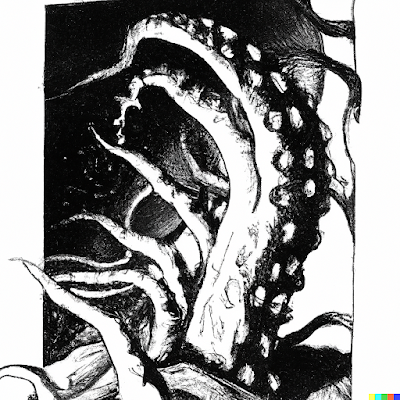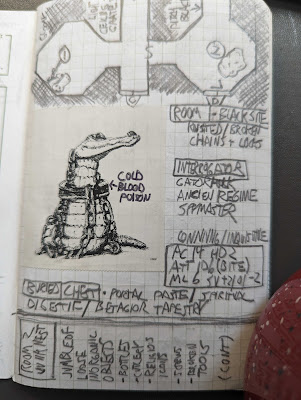Monsters, Monsters, Monsters
Our Dungeon23 generator spat out monsters consecutively for the first three days. Hey, I just work here. Without some empty rooms to space out creatures, we had to get creative with explaining their proximity. Day one was the chained interrogator, day two the kleptoplasm (separated from the interrogator by a secret door), and day three was a tentacle snaking out from the crevasse, which leads down deeper into the dungeon.
Each monster is doing a different job. The interrogator establishes a faction, the fallen ancien regime of the reptilefolk. The kleptoplasm is a solitary, unintelligent/unaligned lair monster. The tentacle is nominally a monster, but is also something of a trap, and really an excuse to draw the characters deeper into the dungeon (it’s literally part of Something Bigger on a lower level). It foreshadows the deeper parts of the dungeon.
For statistics, I am using the following scheme:
NAME (1-3 adjectives) AC X HD X Attack XdY (descriptor) ML SV x/y/z
AC, HD, Attack, and ML are bog-standard for rules-light games in the tradition of B/X D&D. With a little finagling, these could scale up to 5E-level complexity, although damage would need to be increased to keep up with 5E’s resilient characters.
The adjectives are inspired by Ultraviolet Grasslands’ method of presenting monsters, as I talked about previously. The three-part save numbers are inspired by Andrew Kolb’s Oz and Neverland, also addressed in that post. If a monster needs to make a save or ability check, the DM merely has to decide if the monster is good, average, or bad in the relevant area.
Environmental Storytelling
Day four was our first “empty” room. As detailed in Courtney Campbell’s Tricks, Empty Rooms, & Basic Trap Design, one of our sources of inspiration, an empty room is not really empty:
The first and most important thing to remember is that empty rooms aren’t. “Empty” refers to the fact that they lack an antagonist, threat, reward, or something ‘unusual’. The purpose of an empty room is to insure [sic] the players never know which one of these options they are going to face - all rooms devoid of antagonists should appear empty, so that the players never know when a trap, trick or treasure is hidden in front of them.
Empty rooms do a lot of the heavy lifting in establishing the history of the dungeon (what it once was) the current milieu or situation of the dungeon (what it now is) and opportunities for the players to leverage it to achieve their goals (what it may soon be).
Our room four is a dead-end, collapsed inward from a bomb-blast above. We’re still close to the surface, so we want a lot of our rooms to reinforce the revolution that happened up there recently (as implied by our ancien regime). Rooms five and six (also “empty”) include paint from revolutionary graffiti dripping down through cracks and the remains of an anarchist book stash, respectively.
Entrances and Exits
We very intentionally decided that our day one room would not be an entrance to the dungeon. Days five and six provide us with our first entrance and our first point of access to a lower level.
That means that access to level two is quite close to an initial entry point to the dungeon. This serves two purposes. First, it allows the characters to get in over their heads. Yes, day six’s room includes a ladder downward, allowing PCs to very quickly "skip" the first level and get deeper into the dungeon; but that ladder goes down into the same chasm from which the tentacle in room three emerged, so it is certainly not the safest way to get to level two! Second, it provides a fast way for the party to move deeper into the dungeon on repeat visits, after level one itself is no longer of much interest for exploration (and, presumably, after the source of the tentacles is dealt with in some way).
The First Three Pages
Comparing the below image to the one in my previous Dungeon23 post, we can see how the first page has been retroactively filled in with more detail as the subsequent days were completed. As of time of writing, I am (almost) caught up to the present day; but I will hold off on photos of the next few pages, until this kind of retroactive embellishment is complete.






No comments:
Post a Comment